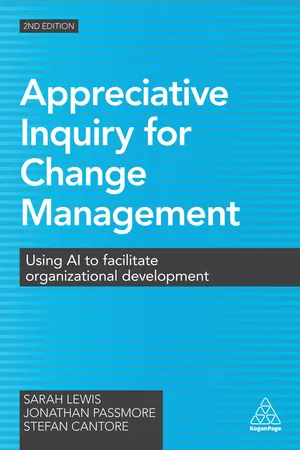![]()
PART ONE
Understanding conversational approaches to change
In this first section we introduce the conversation-based approach to change. However, before we explain what it is, we explain what it isn’t by reviewing the current dominant approach to organizational change. Chapter 1 explores the machine metaphor of organizations that is at the root of so much of our current change-directed behaviour. We consider how this metaphor for understanding organizations became so pre-eminent and how its influence can be detected in unspoken organizational beliefs about people at work, the role of management and how to induce change.
In Chapter 2 we introduce an alternative view of organizations. We consider organizations as living human systems and look at how this different perspective encourages different beliefs about people at work, the role of management and how to effect organizational change. Specifically, we consider the importance of patterns of relationship and communication within organizations for both organizational stability and change.
In Chapter 3 we consider how these conversational approaches to understanding organizations and organizational change have developed from different sources of thought. We notice how, from different origins, they are beginning to converge on some common ground. Particularly, we note what they have to suggest about the nature and role of conversation in organizational life, and why this might be a particularly attractive way of understanding organizations at the beginning of the 21st century.
Finally, in Chapter 4, we examine one conversation-based approach to change in more detail: Appreciative Inquiry. This book is intended to be practical as well as theoretical and we have chosen Appreciative Inquiry as our practical example of a conversational process both because we know it well, and also because there is currently a groundswell of interest in this approach. In this chapter we explain how to set up and run a standard Appreciative Inquiry Summit as an example of conversation-based practice in action.
![]()
01
Organizations as machines, workers as cogs and management as a control process
Introduction
An important feature of the conversation-based approach to organizational change featured throughout this book is that it is based on an understanding of organizations as living human systems. This statement regarding the nature of organizations may seem as if it is stating the obvious. Yet it stands in stark contrast to the widespread if unacknowledged view of them as really just large machines with some human components. This mechanistic view of organizations is a legacy of the Industrial Revolution, and we have chosen to devote this first chapter to illuminating this view in order to throw the difference between these two perspectives into sharper relief.
We begin the chapter by observing the long history of human organization. We notice how the various forms of self-organization developed over time seemed inadequate to the task of meeting the organizational demands of the Industrial Revolution. We explore how the emergence of the large corporations, themselves a response to these challenges, acted as a trigger to questions about the nature of large organizations and to a desire for guidance. From here we single out Frederick Taylor as the architect of the idea of the organization as a machine, an idea that spread through the development and dissemination of his Principles of Scientific Management (1912). Finally, we examine the ongoing impact of Taylor’s blueprint for the efficient organization on many aspects of organizational life. By illuminating the organization-as-machine view in some depth we hope to make it easier to see that the living-human-system view, presented in Chapter 2 and throughout the rest of the book, offers a genuinely alternative way to understand, and work within, organizations.
Organization as a group social skill
Ever since the bigger, better, higher-value coconuts were observed to be on the islands across the channel, interested individuals have found ways to organize themselves into groups to take the risks, and reap the rewards, of being the ones to venture forth. Often these individuals weren’t related, which meant they weren’t operating within the clear framework of obligation provided by family ties. This lack of family ties created the need for more formal agreements regarding the obligations between them. Such agreements had to meet the challenge of ensuring that the relationship between the degree of exposure to risk experienced by each individual, and their share of the rewards, was fair and could be upheld. Many forms of agreement were created to meet these challenges so that people could make the most of the opportunities available for wealth generation. These agreements took such forms as: partnerships, guilds, joint venture companies, joint stock companies, state sponsored companies and companies by Royal Charter.
While all of these organizational structures had their virtues, they also had limitations. Many of these arrangements were time limited, or were for a specific purpose only, and so had to be constructed anew for each new venture. Longer-term agreements ran into difficulties if a founder died or wanted to leave the arrangement, as inheritance issues were difficult to resolve. No agreement was able to solve the problem of unlimited liability for those involved. These various difficulties conspired to ensure that any particular organization rarely lasted any length of time or outlived the founders’ active involvement. Once the Industrial Revolution was under way, requiring huge investment to build canals and railways, these limitations became more pressing (Micklethwait and Wooldridge, 2003).
Fortunately for would-be investors and entrepreneurs, The Companies Act of 1862 provided an answer to the challenges outlined above by making possible the development of the limited liability joint stock company. It is difficult now, since it is such an accepted part of our economic and commercial landscape, to appreciate the revolutionary nature of this piece of legislation. The Act encapsulated three ideas which, put together and enshrined in legal form, changed the organizational environment in an unprecedented way. These ideas were: that a company could be an artificial person; that it could issue tradable shares to any number of individuals; and that the individual investors could all be offered limited liability. The Act facilitated the creation of an entity that had a life of its own, a construction that endured as individuals joined and left. This acted to free the organization from its founders and from reliance on the financial resources of a few socially cohesive people. It also freed organizations from an obligation to have a specific limited purpose such as building a canal, or opening up trading opportunities in India. Now a company could be formed for the general purpose of ‘doing business’, meaning that it could live for ever. The modern corporation now dominates the economic and consumer experience, influencing both how we work and how we consume. The preponderance of big corporations (5.5 million in the United States in 2001 – Micklethwait and Wooldridge, 2003), combined with the prevalence of organizations in the spheres of education, religion and state, ensures that we live our lives within the inescapable context of organizations. No wonder we are interested in how they work and how to improve them.
Taylorism and Scientific Management
One of the first people to engage with the challenge of the modern corporation was the American Frederick Taylor. Born into a Quaker family in 1865, Taylor displayed some interesting personal characteristics from an early age. For example, it is recorded that he was fairly compulsive as a young adolescent, always counting and measuring things with the object of improving how things could be done. He also invented a harness for himself to wear in bed when he was about 12, to stop him turning on his back and so prevent the nightmares from which he suffered. He was very bright and his family had hopes that he would become a lawyer, but he chose instead to study engineering and started in employment as a low-ranking machinist and pattern maker at the Midvale Steel Company. He rose up the organization quickly, becoming chief engineer within six years. During this time he introduced piece-rate working to the organization, and displayed a general interest in studying how jobs were done and how they could be done more efficiently (Burnes, 2000; Papesh, 2006).
These interests in efficiency and innovation are evident throughout Taylor’s career. In 1897 he became a consulting engineer, working to help organizations become more productive and profitable. He noted some of the problems in organizations, such as work-shirking or foot-dragging, and what he called ‘soldiering’, that is, doing the least necessary. He was keen to help organizations reduce this unproductive approach to work. However, his early proposals of how to solve these problems involved a certain amount of what Rose calls ‘managerial thuggery’ (Rose, 1988), such as victimization, sacking and blacklisting of workers he found inadequate. He also introduced very effective time- and motion-based improvements in ways of working and so productivity. His ruthless focus on efficiency gains and cost-cutting (including cutting labour costs) made him many enemies, to the extent that he was removed from his most lucrative and successful assignment at Bethlehem Iron Works in 1901. Following this he devoted his time to developing his comprehensive theory of Scientific Management (Figure 1.1) (Papesh, 2006).
Figure 1.1 A summary of the principles of Scientific Management
Frederick Taylor is extremely important to our understanding of organizations and organizational theory. In 1912 he published The Principles of Scientific Management, and in the same year he was called to attend a Governmental Special Committee established to investigate the Taylor and Other Systems of Shop Management. Off the back of this exposure he toured and lectured extensively, effectively becoming the first management guru or consultant. His advice and guidance were well received by the managers and owners of the...

